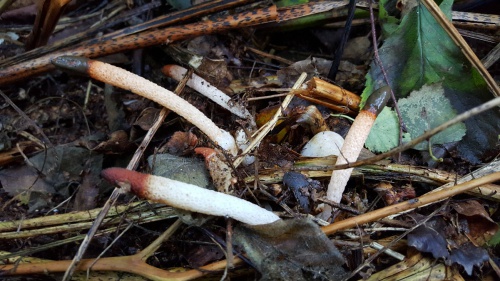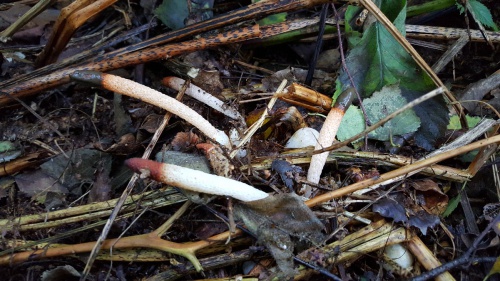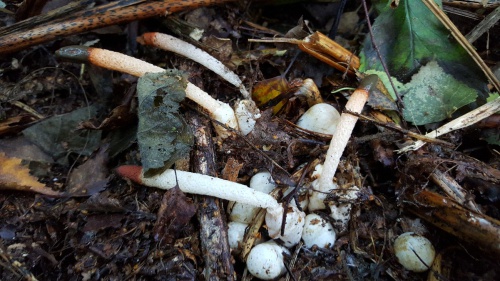Dog Stinkhorn - Mutinus caninus
The 'egg' from which the Dog Stinkhorn develops is usually almost completely buried and difficult to find until the stipe emerges from the egg - unlike the Common Stinkhorn (Phallus impudicus) whose eggs develop with much more exposed above ground. Dog Stinkhorn is much smaller than the Common Stinkhorn - typically 8 to 15cm tall; stipe diameter is 1 to 1.5cm. The cap is honeycombed beneath the gleba (a shiny, sticky, smelly coating that contains the spores). Once insects have consumed the dark olive gleba, the tip of the fungus turns orange and then the whole fruitbody decays rapidly: there is usually nothing left within three or four days.
Saprobic, found growing in small groups and sometimes in fairy rings, most often in coniferous forests and close to rotting stumps of other sources of well-rotted timber. These fungi sometimes fruit on damp old woodchip mulch in parks and gardens.
July to early October in Britain and Ireland.
Widespread but occasional in Britain.
Status in Leicestershire and Rutland not known.
Leicestershire & Rutland Map
Enter a town or village to see local records
MAP KEY:
Yellow squares = NBN records (all known data)
Coloured circles = NatureSpot records: 2020+ | 2015-2019 | pre-2015
UK Map
Species profile
- Common names
- Dog Stinkhorn
- Species group:
- Fungi
- Kingdom:
- Fungi
- Order:
- Phallales
- Family:
- Phallaceae
- Records on NatureSpot:
- 6
- First record:
- 03/10/2016 (Devine, Ben)
- Last record:
- 28/10/2023 (Nicholls, David)
Total records by month
% of records within its species group
10km squares with records
The latest images and records displayed below include those awaiting verification checks so we cannot guarantee that every identification is correct. Once accepted, the record displays a green tick.
In the Latest Records section, click on the header to sort A-Z, and again to sort Z-A. Use the header boxes to filter the list.




